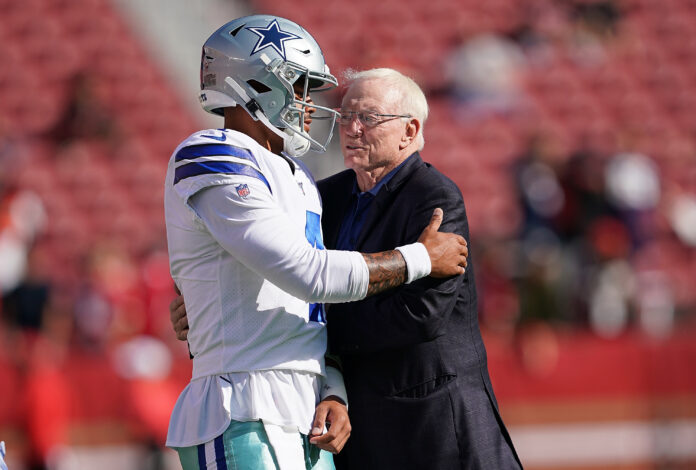In the world of sports, certain positions carry a bit of extra scrutiny. Playing quarterback for the Dallas Cowboys is certainly one of those. Dak Prescott, however, has recently experienced a softer touch.
Take, for example, the 2023 season. While America’s Team started off with a bang, things have fallen off. Prescott, for his part, found himself under particular fire following a meek outing against the San Francisco 49ers. The Cowboys lost 42-10 in what could have been a statement game, and the QB completed 14-of-24 passes for 153 yards with one touchdown and three interceptions.
And while owner Jerry Jones is never shy about levying criticism against his team, he made headlines by unequivocally standing behind his signal-caller.
In reality, though, he doesn’t have much of a choice. The financial realities of Prescott’s contract make it likely that he’ll be playing for the Cowboys for at least another season.
Let’s unpack those numbers and break things down.
Thearon W. Henderson/Getty Images
Prescott’s Contract Makes Him Virtually Unmovable
In the era of Madden and fantasy football, it’s easy to think that a team can simply make changes whenever the roster gets a bit stale. Given the NFL’s hard salary cap, though, that’s simply not possible.
Prescott’s contract is a perfect example of that reality.
After the Cowboys inked their signal-caller to two franchise tags, Prescott agreed to a four-year, $160 million extension. The contract also came with $126 million in guaranteed money and a severely backloaded base salary, both of which make things a bit more complicated.
This year, Prescott carries a cap hit of just under $27 million. While that’s completely reasonable for a starting quarterback, things take a massive leap in 2024, when Prescott will account for 22.5 percent of the Cowboys salary cap ($59.4 million).
If that’s not enough, Dallas can’t free itself of the contract before June 1 to save money; cutting or trading Prescott then would leave the team paying more money rather than less. A post-June 1 move would save money, but that timeline makes things tougher. Teams, understandably, don’t want to wait until the summer to sort out the most important position on the roster. Waiting that long would be especially challenging for the Cowboys because they’d need to line up a replacement.
Add the club’s salary cap situation into the mix—Jones has already spent within $100,000 of the 2024 limit, and that’s not accounting for any potential extensions or additions—and the Cowboys really can’t afford to part ways with Prescott until 2025.
With that in mind, let’s circle back to the owner’s comments on Prescott.
“I believe Dak is a quarterback that can get us to the Super Bowl, and that’s the way that’s gonna be,” Jones said after the loss to the 49ers. “Let me be real clear: Dak’s capable of taking this team where we wanna go.”
Is Prescott talented? Of course, but, at this point, Jones can’t really say anything else. The owner hitched his wagon to the quarterback, and replacing him without sinking the rest of the roster would essentially mean punting on at least the 2024 season.
Faced with that reality, you can’t insist that Dak is not the main man because there’s no real way to change things.
These Sort of Situations Aren’t New in Dallas
While being the owner and general manager of an NFL team may seem like a pretty sweet gig, there are some downsides to that arrangement. As Jones’ tenure in Dallas has showed, the lack of checks and balances can be problematic.
Whether you prefer an old-school example like trading multiple draft picks for wide receiver Roy Williams in 2008 and inking him to a massive contract, or want to be a bit more contemporary like parting with wide receiver Amari Cooper for next to nothing to avoid giving him a relatively reasonable raise, Jones is no stranger to making less-than-ideal choices. And while other general managers might face accountability in the form of losing their job, that isn’t the case when you’re the one signing the checks.
Even if we get a mild show of regret, like wishing for a do-over on the Williams deal, there’s not much accountability.
The same can be said for the Prescott situation. Jones could have stuck (signed an extension earlier) or twisted (moved on to a new starter) sooner, but he inked the quarterback to two franchise tags, then immediately followed with a big-money extension. And that deal was structured in a way that created a massive cap hit at the end of the deal.
Do other general managers make mistakes? Of course, but those executives are staring down unemployment if they get things wrong. In Jones’ case, though, we get statements of confidence.
The owner isn’t going to fire himself. The structure of Prescott’s deal makes it essentially impossible to do anything before June 1, 2024; even a change after that point would be a logistical challenge. So, the only real course of action is to publicly play cheerleader.
So, as the season progresses, remember the realities of Prescott’s contract and the $59.4 million cap hit on the horizon. That, like it or not, will have to color the franchise’s perception of its near future.
Uncommon Knowledge
Newsweek is committed to challenging conventional wisdom and finding connections in the search for common ground.
Newsweek is committed to challenging conventional wisdom and finding connections in the search for common ground.


